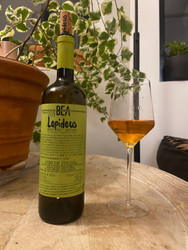Still Stuck in Italy
Posted by Connor Kennedy on October 20 2022 12:54pm
Italy has captured my heart. A bewitching force keeps leading me to their wines, seeking bottle after bottle. I’m often asked: What’s your favorite type of wine? It’s a question I’ve always toiled over and have never been able to properly answer; if the wine is well-made and has a story, I like it. Whether sparkling, amber, white, red, desert, or fortified, I pick no favorites. But lately, there’s just something about Italian wines; their seemingly infinite array of grape varieties coupled with a simply rustic sort of charm has had me entranced. Who knows - this time next year I could be feeling just as strongly about Chilean or Hungarian wines. But for now I must follow my heart. This week I had a superb expression of Trebbiano Spoletino from Giampiero Bea of the Umbrian Bea family, the 2019 “Lapideus”. As playful as some amber or orange wines can be, Bea proves they can possess a profound ethereality that’s simultaneously modest and homegrown. As contradictory as that may sound, it’s the natural outcome to the family’s approach to winegrowing. They prefer the phrase “le goût de terroir” to simply terroir, meaning “taste of the soil”. The Beas are keenly aware that place of production is paramount. The best wine is truly an expression of the earth, in all its facets.
Azienda Agricola Paolo Bea is an esteemed family-run winery in Umbria, a region in the heart of central Italy just southeast of Tuscany. For the patriarch Paolo Bea, family and heritage is as dear as the land upon which the grapes are grown; he picked up his winemaking skills from his own father, and today works closely with his two sons, Giuseppe and Giampiero, who assist in all manner of vineyard and winery operations, and the latter of whom crafted “Lapideus”. They till the land right outside the historic town of Montefalco, where the family can date its roots to the 1500s. The town, whose settlement predates ancient Rome, is primarily known for the Montefalco DOC, of which the reds are blends of mostly Sangiovese and Sagrantino and the whites composed predominantly of Grechetto and Trebbiano Toscano. But there is no shortage of different grape varieties grown around the village, and the family tends to darn well near all of them. The family’s intimacy with the land is hard to overstate - in addition to the 5 hectares of grapevines they cultivate, olives and numerous fruits, vegetables, and grains grow in the hills of their azienda. Fostering this level of biodiversity is a challenge, to be sure, but it's no coincidence that the outcome is extraordinary wine - one can learn much from observing the cycles of nature and how different organisms interact with an environment. A localized sort of wisdom develops, one that cannot be taught but only absorbed over time, vintage after vintage, with nature leading the way.
What then of the fickle thing that’s Trebbiano Spoletino, the grape variety for the “Lapideus” wine? The Trebbiano family of varietals are a group of white grapes that share certain ampelographic characteristics like large grape clusters, robust growth, and a late ripening period. Some Trebbianos share strains of DNA, while others are as genetically distinct as Chardonnay and Rkatsiteli. The most common example is Trebbiano Toscano, which you often see labeled as simply Trebbiano or with its French name Ugni Blanc, but Trebbiano Spoletino has received more attention as of late and is purely Umbrian. Paolo Bea has played a vital role in bringing attention to this grape as a single-varietal wine, where it tends to showcase a high yet balanced acidity complementing a rich, savory structure.
Giampiero Bea’s “Lapideus”, of course, is a skin-contact wine, so it shows another mystifying side of this elegant grape variety. There’s no doubt some amber wines have the tendency to be wines of process rather than wines indicative of grape variety and terroir. In other words, certain approaches to macerations or other interventions in the winery can cloak the inherent qualities of the grape and any unique connection to the land. Not so with “Lapideus”. Trebbiano Spoletino is a versatile varietal, and Bea knows it - it’s why the family’s various cuvees featuring the grape are uniquely expressive of the terroirs on their azienda, even with extended macerations.
This is a vertical, acid-driven wine, coming from a cooler micro-climate than the estate’s other skin-contact Spoletino, the “Arboreus”. The higher acid found in here is evidence of its terroir’s unique expression, lending an extra lift to the citrus and tropical fruit qualities on the palate that might have otherwise sat on the periphery. But this a complex wine - expect too an array of spice and herbaceous qualities with a more subtle salinity to finish. The wine’s maceration built a structure that highlights all this rather than obscuring it. Drink this, and reap the fruits of Giampiero Bea’s labor.
There was a quote on the Azienda’s website that caught my eye, as it succinctly captures the principles guiding its winemaking: “nature should be observed, listened to and integrated, not dominated. Wine is not made by man but generated by nature!”. Not only is this a thoughtful perspective towards tending the earth, but it also truly yields the best possible wines. But man too is generated by nature, and we must find the right way to integrate ourselves into its most ineffable processes. I think we’re all still figuring it out.


